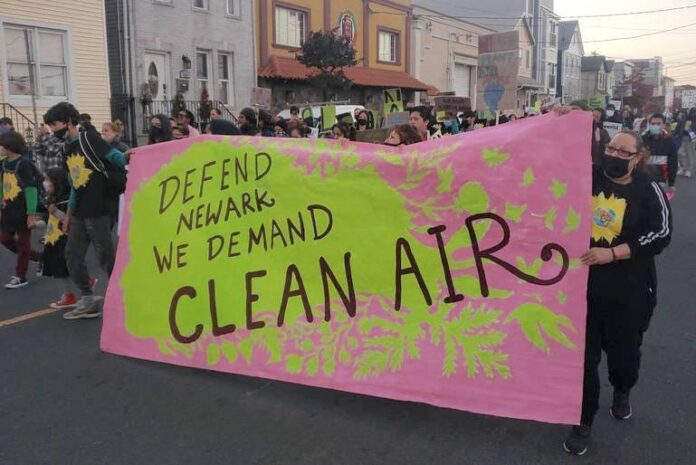The Ironbound neighborhood of Newark, New Jersey, known for its vibrant cultural diversity and rich history, is also home to some of the most densely concentrated industrial areas in the state. From chemical plants and refineries to a major port and a sprawling wastewater treatment facility, the neighborhood is no stranger to environmental challenges. Now, community groups are facing off against a controversial proposal that could introduce yet another source of pollution: a new gas-powered power plant at the Passaic Valley Sewage Commission (PVSC) facility.
A Neighborhood Already Overburdened
If you’ve ever visited the Ironbound, you’ve likely encountered the region’s signature odor — a pungent, chemical-like smell that lingers in the air. According to Gustavo Alcocer, a project manager at the Ironbound Community Corporation (ICC), the foul stench likely originates from the PVSC wastewater treatment plant, which discharges chemicals into the atmosphere. Alcocer explains, “The smell is disgusting. It’s really intense — I get headaches just being there.”
The air in the Ironbound is already thick with pollution. Industrial plants, diesel trucks, and an incinerator that processes much of New York City’s trash contribute to the area’s toxic load. With such environmental stressors already present, the ICC and local residents argue that adding another fossil-fuel power plant to the area is both unnecessary and harmful.
“We already have enough pollution here,” Alcocer said, echoing the sentiments of many who are concerned about the long-term health effects. This vocal opposition has led to legal action aimed at halting the construction of the proposed power plant, which would be the fourth such facility at the PVSC site.
The Push for Clean Energy Alternatives
The push for the power plant stems from the aftermath of Hurricane Sandy in 2012. The storm caused severe flooding along the Passaic River, which resulted in an electrical blackout at the PVSC facility. With no power, the plant was forced to discharge nearly a billion gallons of untreated sewage into Newark Bay. To prevent future disasters, the PVSC has proposed the construction of a new gas-powered plant designed to provide emergency backup power during crises.
While the intention may seem rooted in disaster preparedness, many local residents and environmental advocates argue that the solution is shortsighted. The Ironbound already struggles with some of the highest asthma rates in the country, a direct consequence of its exposure to air pollution from nearby industrial operations. Community groups, led by the ICC, are calling on PVSC to consider renewable energy options instead of expanding fossil-fuel infrastructure in an already overburdened neighborhood.
“We don’t need more pollution. We need cleaner, healthier energy solutions,” said Alejandra Torres, assistant director of advocacy and organizing at the ICC. Torres believes that the proposed power plant would exacerbate existing environmental and public health disparities, particularly among the community’s most vulnerable populations.
The Legal Battle
The fight against the power plant has reached the courts. Newark’s city government has filed a lawsuit claiming that PVSC violated the terms of its environmental permits, arguing that the proposed plant would increase pollution in an already heavily impacted area. Meanwhile, the ICC has filed its own lawsuit under New Jersey’s 2020 Environmental Justice Law, which prohibits the construction of new polluting facilities in communities that are already facing environmental burdens.
The legal challenges focus on two main points: the potential health risks posed by the new plant and the failure of PVSC to explore renewable energy alternatives. Despite receiving six proposals for renewable energy solutions, PVSC chose to move forward with a gas-powered plant, citing concerns about reliability and cost. In June, the commission awarded a $232.7 million contract to build the gas plant, which would run on natural gas to provide emergency power during electrical outages.
“Why does the Ironbound have to be sacrificed again and again for the sake of the larger state?” Torres asked, pointing to the disproportionate environmental burdens placed on Newark’s residents.
The Road Ahead
This legal battle is not just about halting the construction of a new power plant; it’s about rethinking how the region handles its energy needs. Advocates like Torres argue that Newark deserves to have a say in the kind of energy infrastructure that gets built in their neighborhood. The lawsuit is a call for greater community involvement in decision-making, especially when it comes to projects that could have long-term health and environmental consequences.
The push for renewable energy alternatives has gained momentum in recent years, with many seeing the transition to cleaner energy as an essential step in addressing climate change and reducing harmful pollutants. While PVSC’s proposed gas plant may serve an immediate need for backup power, community members and environmental groups are calling for more forward-thinking solutions that prioritize sustainability, equity, and the health of Newark’s residents.
A Community’s Stand
The controversy surrounding the proposed power plant is emblematic of broader struggles faced by industrial communities around the nation. For the residents of the Ironbound, this fight is about more than just air quality; it’s about their right to live in a healthy environment and to have a voice in shaping the future of their community.
As the legal battles continue, advocates are calling on both state and local officials to prioritize the health and well-being of Newark’s residents. They argue that the future of energy in New Jersey should be one that is cleaner, safer, and more sustainable — a future that doesn’t come at the expense of the people who have already borne the brunt of industrial pollution for far too long.
For more on the ongoing legal challenges and efforts to shift towards renewable energy in New Jersey, visit the business section of Explore New Jersey.











